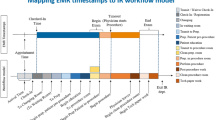Abstract
In this paper, a Markov chain model is developed to model the work flow in a computed tomography (CT) imaging department at University of Wisconsin Medical Foundation. Using this model, we estimate the patient length of stay and investigate different configurations of radiology specialists for potential efficiency improvement to reduce flow time and cost. What-if analysis is carried out to investigate the impact of various staffing levels and sensitivity study is used to identify the bottleneck operation, i.e., the most impeding one whose improvement can lead to the highest productivity increase.


Similar content being viewed by others
References
Fomundam S, Herrmann J (2007) A survey of queuing theory applications in health care. Technicial report No. 2007-24, the Institute for Systems Research, University of Maryland, College Park
Koizumi N (2002) A queueing network model with blocking: analysis of congested patients flows in mental health systems. PhD dissertation, University of Pensylvania, Philadelphia
Caglar T (2005) A queueing theoretic approach to gridlock prediction in emergency departments. Master Thesis, Virginia Polytechnic Institute and State University, Blackburg
Green LV (2006) Queueing analysis in healthcare. In: Hall RW (ed) Patient flow: reducing delay in healthcare delivery, vol 91. Springer, New York, pp 281–308
Green LV et al (2006) Using queueing theory to increase the effectiveness of emergency department provider staffing. Acad Emerg Med 13(1):61–68
Au-Yeung SWM, Harrison PG, Knottenbelt WJ (2007) Approximate queueing network analysis of patient treatment times. In: Proceedings of the 2nd international conference on performance evaluation methodologies and tools, vol 321, ariticle 45
de Bruin AM et al (2007) Modeling the emergency cardiac in-patient flow: an application of queuing theory. Health Care Manag Sci 10(2):125–137
Creemers S, Lambrecht MR (2007) Modeling a healthcare system as a queueing network: the case of a Belgian hospital. Techinical Report 0710, Department of Decision Sciences & Information Management, Research Center for Operations Management, Katholieke Universiteit Leuven, Leuven, Belgium
Creemers S, Lambrecht MR (2008) Healthcare queueing models. Techinical Report 0804, Department of Decision Sciences & Information Management, Research Center for Operations Management, Katholieke Universiteit Leuven, Leuven, Belgium
Glance L (2000) The cost effectiveness of anesthesia workforce models: a simulation approach using decision-analysis modeling. Anesth Analg 90(3):584-592
Needleman J et al (2002) Nurse-staffing levels and the quality of care in hospitals. N Engl J Med 346(22):1715–1722
Curtin LL (2003) An integrated analysis of nurse staffing and related variables: effects on patient outcomes. Online J Issues Nurs 8(3):118–129
Kane RL et al (2007) The association of registered nurse staffing levels and patient outcomes: systematic review and meta-analysis. Med Care 45(12):1195–1204
Spry CW, Lawley MA (2005) Evaluating hospital pharmacy staffing and work scheduling using simulation. In: Kuhl ME, Steiger NM, Armstrong FB, Joines JA (eds) Proceedings of the 2005 winter simulation conference, pp 2256–2263
Kumar A, Shim SJ (2006) Simulating staffing needs for surgical instrument distribution in hospitals. J Med Syst 30(5):363–369
Ahmed MA, Alkhamis TM (2009) Simulation optimization for an emergency department healthcare unit in Kuwait. Eur J Oper Res 198(3):936–942
Brenner S et al (2010) Modeling and analysis of the emergency department at University of Kentucky Chandler Hospital using simulations. J Emerg Nurs 36(3):303–310
Reynolds J et al (2010) Design and analysis of a health care clinic for homeless people using simulations. Int J Health Care Qual Assur 23(5):607–620
Wang J et al (2011) Reducing length of stay in emergency department: a simulation study at a community hospital. IEEE Trans Syst Man Cybern Part A (in press)
Zeng Z et al (2011) Improving quality of care of emergency department at a community hospital: a simulation study. J Emerg Nurs. doi:10.1016/j.jen.2011.03.005
Jacobson SH et al (2006) Discrete-event simulation of health care systems. In: Hall RW(ed) Patient flow: reducing delay in healthcare delivery, vol 91. Springer, New York, pp 211–252
Centeno MA et al (2000) A simulation study of the radiology department at JMH. In: Proceedings of winter simulation conference, pp 1978–1984
Ramakrishnan S et al (2004) A study of the CT scan area of a healthcare provider. In: Proceedings of winter simulation conference, pp 2025–2031
Joffe S et al (2007) Radiology operations: what you don’t know could be costing you millions. Radiol Manage 29(4): 20–31
Germann JW, Hagg H (2007) Implementing Lean/Six Sigma methodologies in the radiology department of a hospital healthcare system. RCHE Publications, paper 27
Berg B et al (2010) A discrete event simulation model to evaluate operational performance of a colonoscopy suite. Med Decis Mak 30(3):380–387
Li J, Meerkov SM (2009) Production systems engineering. Springer, NY
Acknowledgements
The authors would like to thank J. Fenske, F.-H. Liu, B. S. Simpson of University of Wisconsin - Madison for their work on data collection and initial analysis, and thank E. Konkol of University of Wisconsin Medical Foundation for coordinating the project, and the staffs at Medical Imaging Department of University of Wisconsin Medical Foundation for their help.
Author information
Authors and Affiliations
Corresponding author
Additional information
This paper is supported in part by NSF Grant No. CMMI 1063671.
Rights and permissions
About this article
Cite this article
Wang, J., Quan, S., Li, J. et al. Modeling and analysis of work flow and staffing level in a computed tomography division of University of Wisconsin Medical Foundation. Health Care Manag Sci 15, 108–120 (2012). https://doi.org/10.1007/s10729-011-9188-1
Received:
Accepted:
Published:
Issue Date:
DOI: https://doi.org/10.1007/s10729-011-9188-1




